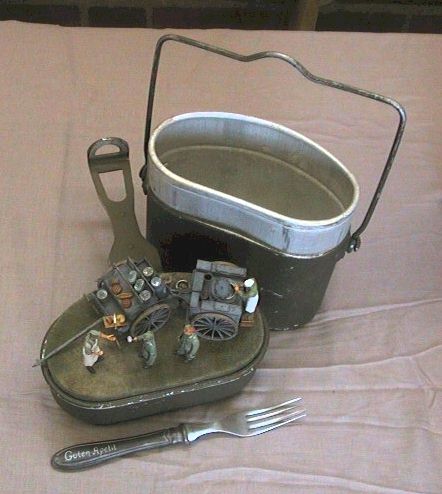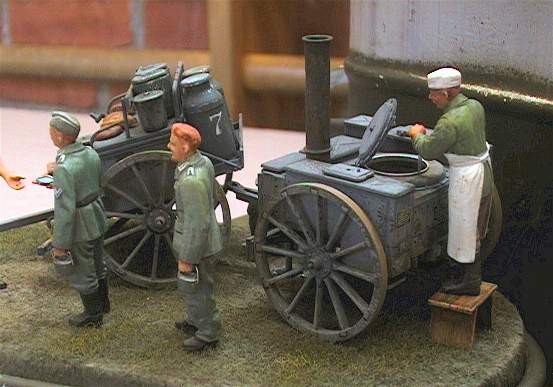German Field Kitchen Vignette
Model by Bengt-E Johansson
Text and photos by Martin Waligorski
Sometimes the best idea is the simplest one. Check this  small field kitchen scene by Bengt-E Johansson. So straightforward means, so telling! Different, yet familiar. A recipe for an outstanding vignette!
small field kitchen scene by Bengt-E Johansson. So straightforward means, so telling! Different, yet familiar. A recipe for an outstanding vignette!
What is even more noteworthy is that there is nothing particularly special about the kit used for the vignette. Only one kit was used out-of-the-box, Tamiya German Field Kitchen Scenery. The kit is actually a reincarnation of Tamiya’s 1978 release of Gulaschkanon. This earlier kit had two horses and a driver and was in the towed configuration. The latest kit has deleted the horses and given new figures instead.
Bengt-E has researched the subject well. The typical Wehrmacht food consisted of soup based on potatoes and pork meat served with dark rye bread plus hot wheat ”coffee”. All these elements have been replicated in the scene.
The mess kit serving as a base/case for the vignette is of Swedish Army origin. Mess kits remained an essentially unchanged element of the military equipment for the last 80 years or so, so it fits the purpose well despite not being ”accurate” for German army scene. Real signs of wear on the kit add a sense of patina to the entire scene. Note that painting and weathering on the vignette is first-class, down to the similar signs of wear on scale pots!
Old-style aluminium fork (remember these?) with engraved inscription Guten Apetit completed the display setting.
Due to their function, Gulaschkanone were essential vehicles of the wartime Wehrmacht. In fact, each army division had not only a set of mobile kitchen units, but also own baking and butcher companies.
It is perhaps strange that despite all the innovations in the field of mechanization, German industry could never supply enough vehicles (or fuel) to motorize the whole army, and horse drawn vehicles and guns were used right up to the last days of the war. The Tamiya kit represents the Grosse Feldkuche Hf.13, a two-wheeled field kitchen with wooden iron-clad wheels, looking more as a relic from the era of trench warfare rather than Blitzkrieg.
The main (rear) carriage of the kitchen was essentially a moving stove, housing a 200-litre soup pot, 90-litre coffee maker with tap dispenser and a stove plate used to cook potatoes and sausages. The separate front carriage served as a seat for the coachman and the cooking crew and had a food storage space below the seats.
A single field kitchen unit could feed up to two hundred men.
This article was originally published in IPMS Stockholm Magazine in December 2002.

